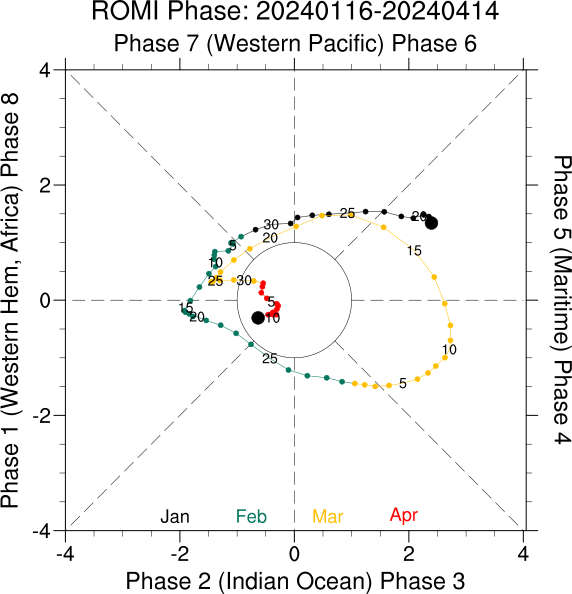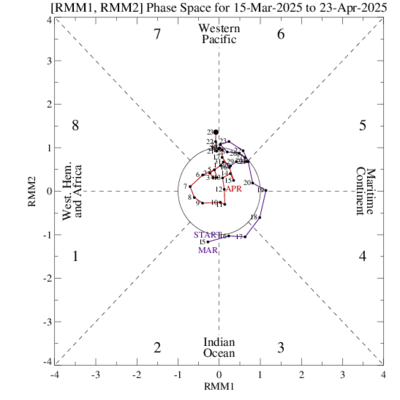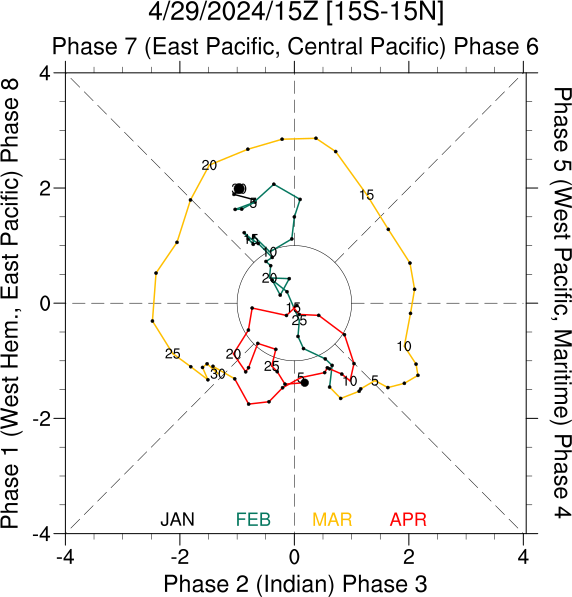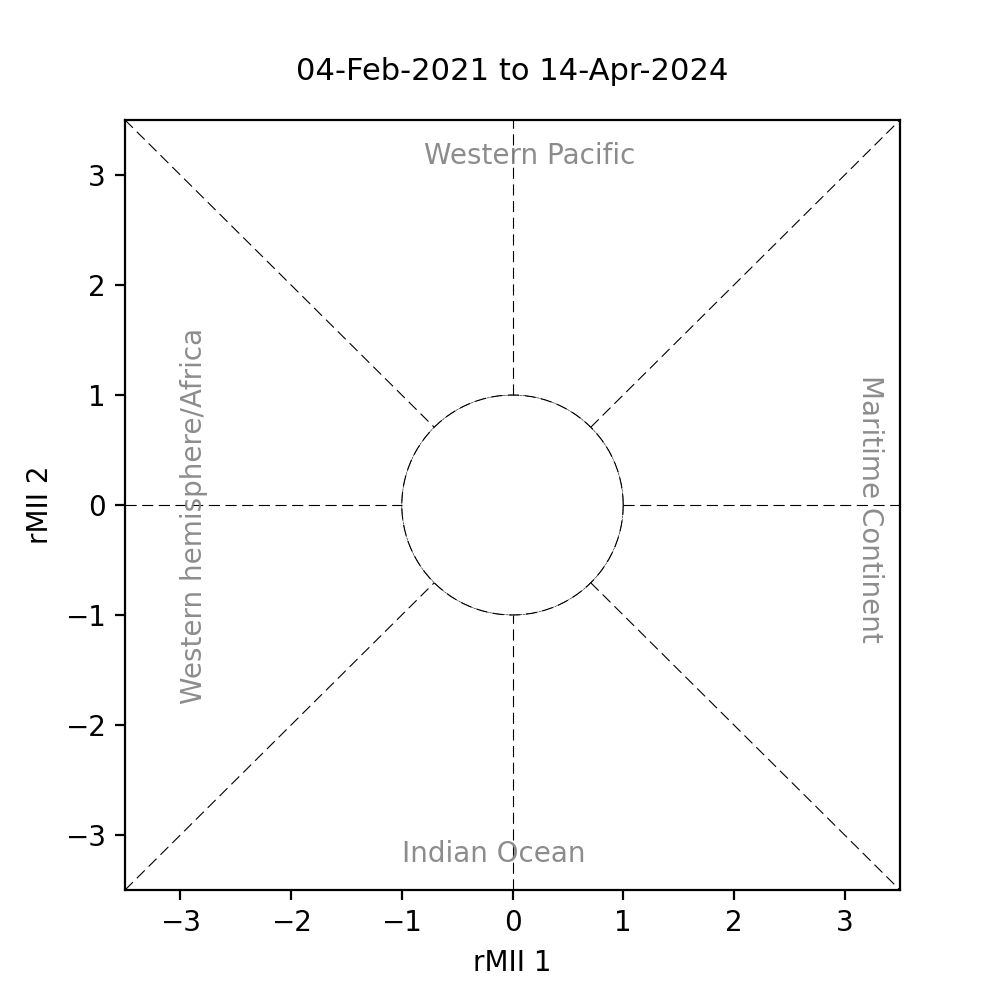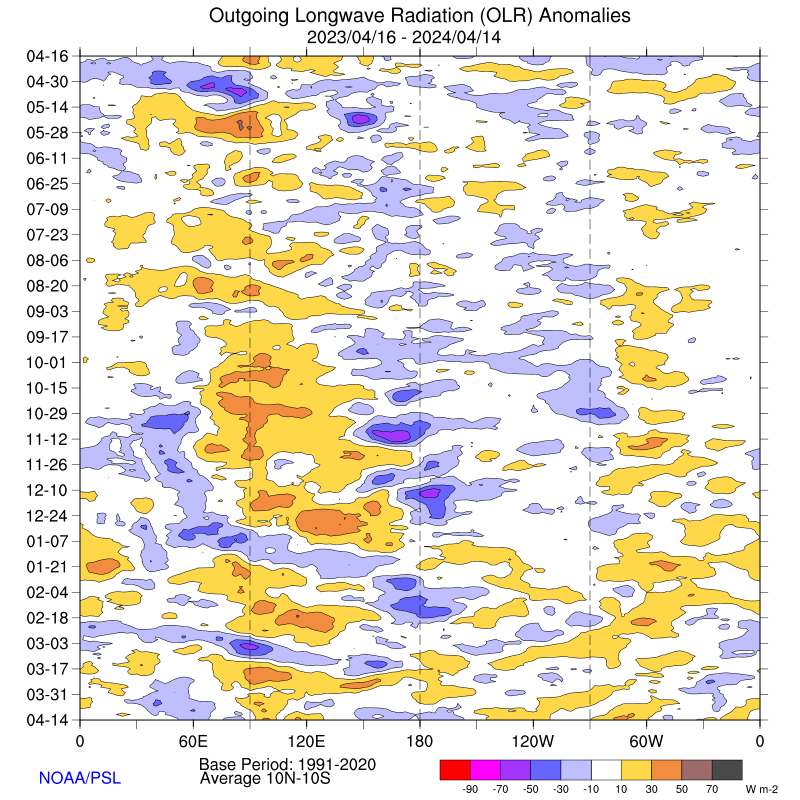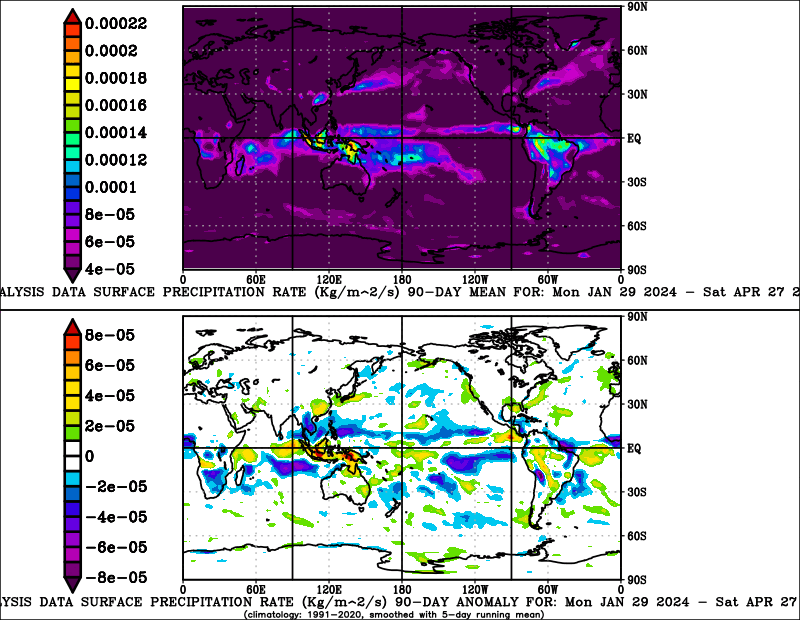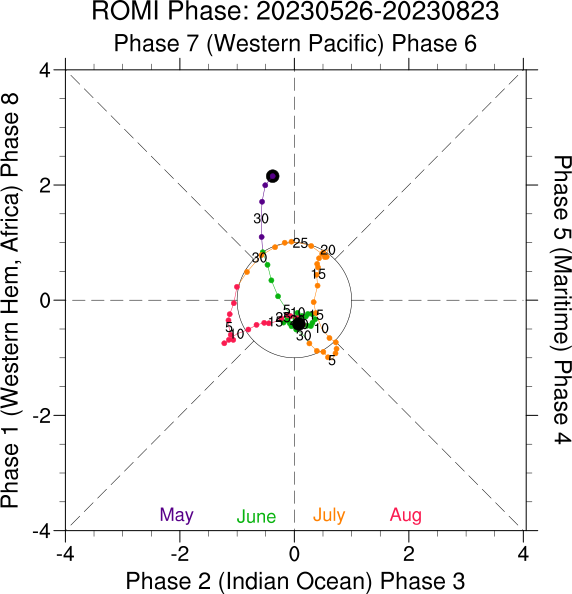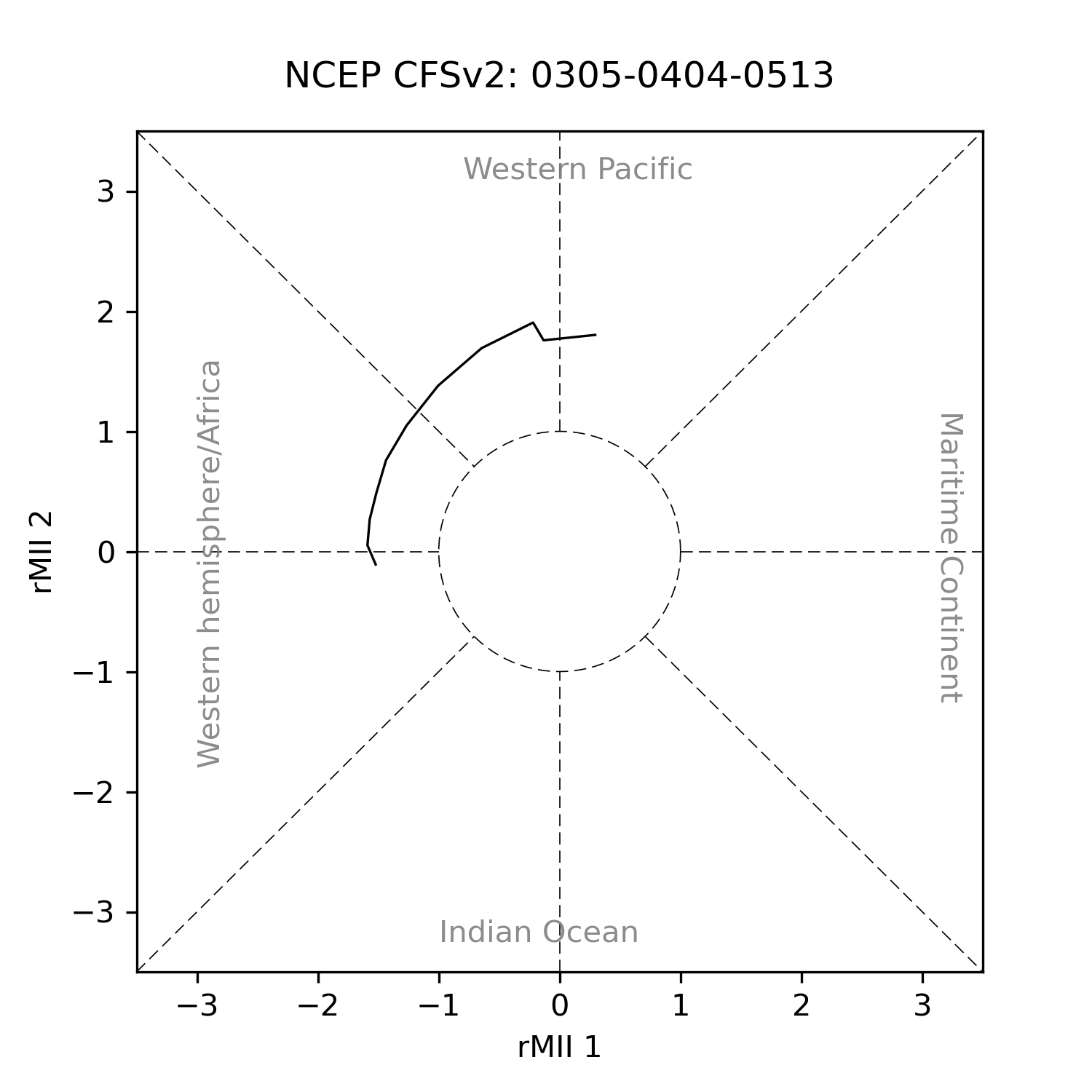Madden-Julian Oscillation (MJO)

Current Status
The purpose of this page is to provide ways to assess and view the current MJO status.
Phase Diagrams
Atmosphere:
Satellite picture:
MJO Indices
The links and descriptions are below as well as links to some other MJO timeseries created at other institutions.
A description of the timeseries format is available. NOTE: ROMI has been updated through September 24 2023.
The OMI has been updated through December 31 2022. These PC amplitudes will differ slightly from the previous version since the sample used for the 20-96 day filter is longer (1979-2021), resulting in slightly different values for the filtered OLR used to calculate OMI. In some cases this may also result in a phase difference (by one phase) from the previous versions. The EOFs used are still from 1979-2012 (see below). The previous (1979-2021) version of OMI can be obtained here. NOTE: When comparing OMI directly with RMM, to obtain the proper phase the sign of OMI PC1 and the PC ordering should be reversed, so that OMI(PC2) is analogous to RMM(PC1) and -OMI(PC1) is analogous to RMM (PC2).
Daily MJO index time series from 1979
| Index | Description | Obtain timeseries |
|---|---|---|
| OMI The OLR MJO Index | Projection of 20-96 day filtered OLR, including all eastward and westward wave numbers onto the daily spatial EOF patterns of 30-96 day eastward filtered OLR. | OMI values |
| OOMI The Original OLR MJO Index | Projection of 30-96 day eastward only filtered OLR onto the spatial EOF patterns of 30-96 day eastward filtered OLR. This results in a smoother index than OMI due to more restrictive filtering. | OOMI values |
| ROMI The Real-time OLR MJO Index | Projection of 9 day running average OLR anomalies onto the daily spatial EOF patterns of 30-96 day eastward filtered OLR. OLR anomalies are calculated by first subtracting the previous 40 day mean OLR. The running average is tapered as the target date is approached. | ROMI values |
| FMO The Filtered OLR MJO index. | Univariate EOF of normalized 20-96 day filtered OLR averaged from 15S-15N, by longitude. The same spatial EOF pattern is used for the entire year (see below). | FMO values. |
| VPM The Velocity Potential MJO index. | Calculated in the same way as the Wheeler-Hendon RMM, except using 200 hPa Velocity Potential instead of OLR, along with U200 and U850 in a combined EOF (see link to Ventrice et al. 2013 below). | VPM values |
| RMII The realtime Multivariate Index for tropical Intraseasonal oscillations. | Projection of 9 day running average anomalies onto the daily spatial multivariate EOFs of 20-96 day eastward filtered OLR, U850 and U200. Anomalies are calculated by first subtracting the previous 40 day mean. The running average is tapered as the target date is approached. | RMII values |
| REOMI The Rotated EOFs OLR Madden Julian Index. | Projection of 20-96 day filtered OLR, including all eastward and westward wave numbers onto the rotated daily spatial EOF patterns of 30-96 day eastward filtered OLR. EOFs are calculated using OLR from 1979-2012. PCs are calculated from 1979-2022. EOFs are rotated to reduce noise and potential degeneracy issues as detailed in Weidman et al., 2022. | REOMI values |
| KRMM The Koopman Real-time MultiVariate Madden Julian Index | Calculated following the Wheeler-Hendon RMM, but using Koopman spectral analysis to compute eigenfunctions. The leading mode of intraseasonal variability is rotated to maximize correlation with the standard RMM. See link to Lintner et al. 2023 for further discussion of the Koopman spectral analysis and methodological details. | KRMM values |
A python routine to calculate the OMI has been developed for use on real-time and model data, and can be accessed via GitHub at: https://github.com/cghoffmann/mjoindices and also at Zenodo: https://doi.org/10.5281/zenodo.3613752. For the REOMI, code is in the same repository. using the parameter eofs_postprocessing_type="eof_rotation" in the main method for calculating EOFs: omi.omi_calculator.calc_eofs_from_olr(). No other changes should be necessary from the standard OMI calculation. Details of the implementation of this software are outlined in the journal article: Hoffmann CG, Kiladis GN, Gehne M, von Savigny C 2021 A Python Package to Calculate the OLR-Based Index of the Madden-Julian-Oscillation (OMI) in Climate Science and Weather Forecasting. Journal of Open Research Software, 9:9. DOI: https://doi.org/10.5334/jors.331/ (PDF)
The rMII code and MII values are available upon request from the lead author (Shuguang Wang: wangsg@outlook.com). For more information for all indices other than the VPM and rMII, please read the article "A comparison of OLR and circulation based indices for tracking the MJO". We ask that if you use the timeseries in you research that, please cite that paper, e.g.:Python routines to calculate OMI
MATLAB routines to calculate KRMM
- courtesy of Dimitrios Giannakis at:https://github.com/dg227/NLSA/tree/master/pubs/LintnerEtAl23_GRL
Composite streamfunction and OLR patterns for RMM and OMI based on the events that exceed 1 standard deviation for each phase of the PC combination.
These are based on data from 1979 through 2012, and the number of events in each composite is given as "N= " at the bottom of each plot. Blue shading denotes negative OLR anomalies (regions of convection) and red positive (suppressed), with two levels of shading at +- 10 and +- 6 W/m**2. Streamfunction contour interval is 5 X 10**5 m**2/s at 200 hPa, and 2 X 10**5 m**2/s at 850 hPa. To facilitate comparison with RMM, these composites are constructed by reversing the sign of OMI PC1 and the OMI PC ordering, so that OMI(PC2) is analogous to RMM(PC1) and -OMI(PC1) is analogous to RMM(PC2), as described in Kiladis et al. 2014.- 200mb OMI DJF
- 200mb OMI JJA
- 200mb RMM DJF
- 200mb RMM JJA
- 850mb OMI DJF
- 850mb OMI JJA
- 850mb RMM DJF
- 850mb RMM JJA
MJO EOF Patterns
OMI EOF patterns.
- The ASCII EOF values are available via ftp/downloads for EOF1 and EOF2 . They can be read using the code read.eof.f. User can retrieve the files via the web or using an (anonymous) ftp client at the address ftp2.psl.noaa.gov. Then, cd to /Datasets.other/MJO/.
OMI EOF Animations
- An animation of the daily OMI EOF's (realtime player format).
- A javascript animation of the daily OMI EOF's.
VPM EOF patterns.
- The VPM EOFs are computed using zonal wind and velocity potential based on NCEP reanalysis version 1 from 1979 to 2012.
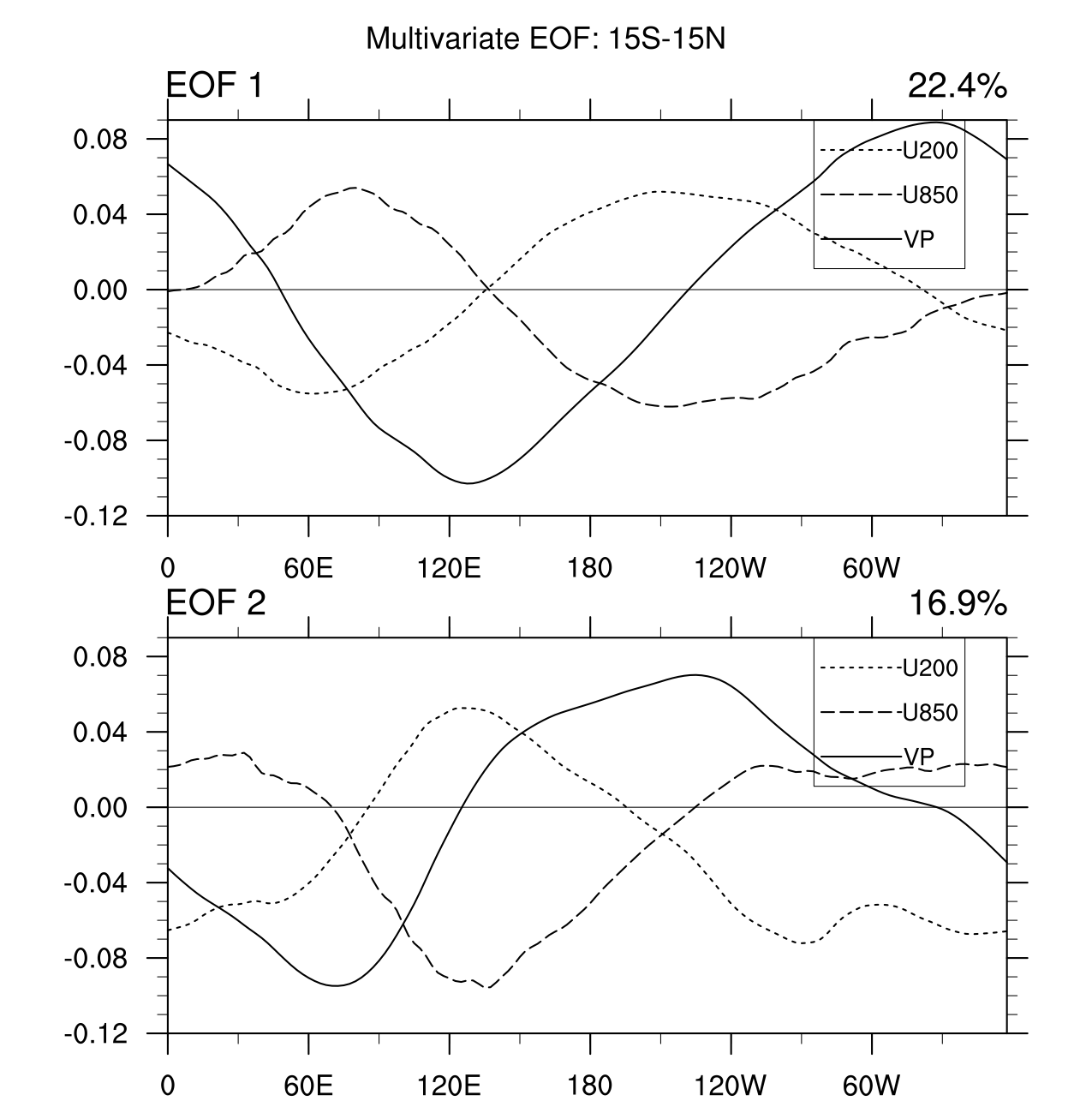
FMO EOF patterns.
- The ASCII FMO EOF values are available from here.
FMO Spatial EOFs 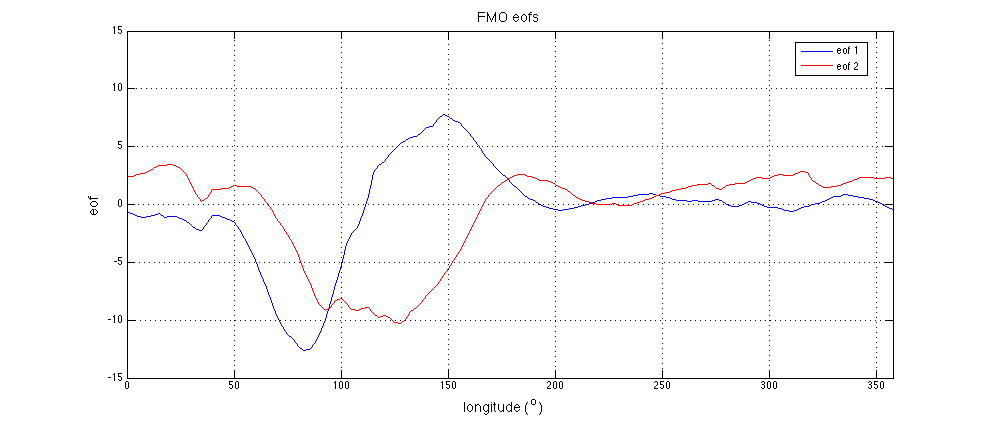
Phase Diagrams
rMII was computed using OLR and 850hPa and 200hPa zonal winds from ERA5. PC signs are consistent with the RMM index for the phase plots.
Other MJO indices
- The All-season Real-time Multivariate (RMM) MJO Index (Wheeler-Hendon) from the The Centre for Australian Weather and Climate Research.
- Bimodal ISO Index for historical data analysis and real time monitoring from the International Pacific Research Center.
- Carl Schreck's analysis of the RMM components.
Forecasts
Primer
An MJO Primer: What is an MJO and how does it affect the weather?
The Madden-Julian Oscillation is a mode of sub-seasonal atmospheric variability that influences the location and strength of tropical precipitation as in this classic schematic (left)
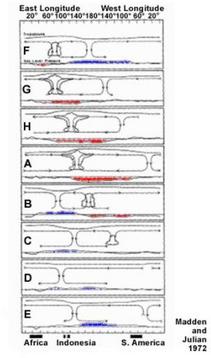 |
The MJO was first described in 1971 but a field project held over the west equatorial Pacific during 1992-93 raised awareness of the MJO as a coherent phenomenon, possibly useful for weekly predictions of tropical precipitation and extratropical weather patterns. The MJO is best defined over the oceanic warm pool, which extends from the Indian Ocean to the central Pacific and where complex variations of precipitation occur from day to day. The warm pool is generally defined by sea surface temperatures that are > 28C. As a result of this intense activity, the MJO is sometimes difficult to see in a sequence of satellite pictures of the Tropics. This link shows a satellite animation of a strong MJO that occurred during December 2003 to January 2004. Note the non-steady or transient nature of the convection, some of which can be seen more clearly when the data are averaged in space or time. Ways to monitor the MJO are illustrated later.
b) How can an MJO affect the weather?
When an MJO moves eastward through the Indo-Pacific Ocean region, it produces large, slowly changing departures from the normal tropical precipitation. These departures change the atmospheric circulation and, through the phenomenon of Rossby wave dispersion, the changes can propagate into higher latitudes. The accompanying picture
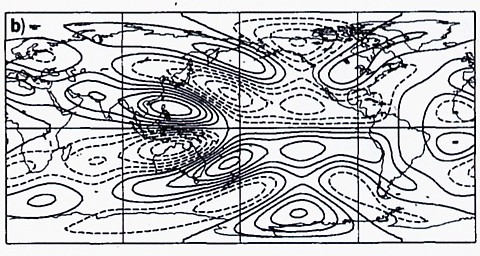 |
| Rossby Wave Propagation |
c) How do MJOs interact with slower climate processes like ENSO?
MJOs may play a role in the transition to an El Nino or La Nina.This means they help determine details of the timing and/or amplitude of a warming or cooling event. However, the transitional stage of an ENSO event is complicated and the MJO's role is still being investigated. MJOs were prominent during the 1996-97 northern winter at the early stage of the 1997-98 El Nino and this led to heightened awareness of a possible MJO-ENSO link.The 1996-97 MJO activity was by some measures the greatest in the ~30 year record of outgoing longwave radiation (OLR, a proxy for deep tropical convection). On the other hand, 1997-98 had the weakest activity in the record.The two years are contrasted here using a time-longitude or Hovmoller diagram of total OLR for 1996-97 and 1997-98
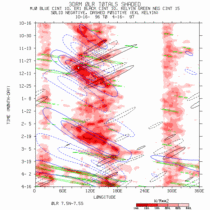 |
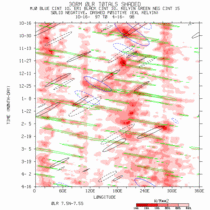 |
| 1996-97 OLR | 1997-98 OLR |
Once SST anomalies associated with an ENSO are in place, the MJO life cycle is influenced by the SST anomalies. When or if an MJO develops, the simplest effect during El Nino is a farther eastward movement of the convection into the central Pacific whereas during La Nina the convection anomalies barely get into the western Pacific. In both cases the MJO still "starts" over the Indian Ocean.
Despite this influence on the MJO life cycle, it is
unclear whether overall MJO activity is influenced by the phase of the
ENSO cycle. The natural variation of MJO activity is too large and observed
datasets are too short to provide a definitive answer to this question.
Transient convection at all time scales increases when sea surface temperatures
(SST) reach ~ 29C (84F). On the other hand, there is a significant relationship
between MJO activity and SST anomalies over the western Pacific Ocean (140-180E).
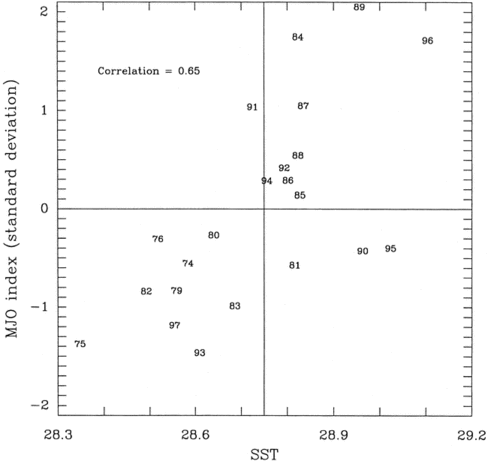 |
| Scatter plot of SST vs. MJO activity |
d) How can the atmosphere and ocean signals associated with the MJO be determined?
The MJO life cycle can be broken down into stages using an index based, for example, on the location of the MJO's tropical convection anomaly. The atmosphere's observed large-scale circulation and/or local weather anomalies can then be averaged over many cases to produce a "composite" `anomaly for each stage. Time filtering is usually applied to exclude higher and lower frequency variability. The results produce an estimate of the MJO signal or influence based on the observational record. The composite anomalies of circulation and weather are generally weak in the extratropics and moderately strong in the tropics and subtropics. They will be described in more detail later.
e) How do MJOs interact with faster weather processes like synoptic scale waves and wavetrains?
The composite anomalies, assuming they are statistically significant and large enough, produce persistent (1-3 week) changes in the atmospheric flow due to the MJO. These changes can influence the development and propagation of synoptic-scale weather systems, i.e. they influence the storm track. For example, during one stage Pacific Ocean storms tend to be stronger and farther south when they make landfall on the U.S. west coast. At the opposite stage the storm or wave energy may split and move south into the tropics and north into Canada, favoring storms over the central U.S. Plains. Because the MJO extratropical signal is weak there are large variations of the actual circulation or weather observed in individual cases. Other processes may overwhelm or mask the MJO signal.
Daily monitoring of many individual cases has produced qualitative evidence for interaction between the circulation induced by flare-ups of convection within the MJO's convective envelope and synoptic scale waves or wavetrains passing by in mid-latitudes and the subtropics. These daily interactions are large amplitude and sometimes contribute to the rapid initiation of the composite MJO signal and/or major transitions in weather patterns.Until GCMs are able to simulate MJOs, we rely on daily monitoring and a subseasonal synoptic model to provide an early indication of such situations.
f) How is the MJO signal extracted from climate forecasts?
This section will discuss how the MJO signal is pulled from models
and forecasts. Ideally, the MJO signal in the forecasts in the group will
be displayed here. Advatanges and disadvantages of the different methods
will be discussed.
Project on EOFs
- Time filter
- Model only MJO
- Space-time filter
References
2022
- Amaya, D. J., M. G. Jacox, J. Dias, M. A. Alexander, K. Karnauskas, J. D. Scott and M. Gehne (January 2022): Subseasonal-to-seasonal forecast skill in the California Current System and its connection to coastal Kelvin waves. J. Geophys. Res. Oceans, 127 (1), e2021JC017892, https://doi.org/10.1029/2021JC017892..
- Bengtsson, L., L. Gerard, J. Han, M. Gehne, W. Li and J. Dias (December 2022): A Prognostic-Stochastic and Scale-Adaptive Cumulus Convection Closure for Improved Tropical Variability and Convective Gray-Zone Representation in NOAA’s Unified Forecast System (UFS). Mon. Wea. Rev., 150 (12), 3211–3227, https://doi.org/10.1175/MWR-D-22-0114.1.
- Berrington, A. H., N. Sakaeda, J. Dias and G. N. Kiladis (August 2022): Relationships Between the Eastward Propagation of the Madden-Julian Oscillation and its Circulation Structure. J. Geophys. Res. Atmos., 127 (16), e2021JD035806, https://doi.org/10.1029/2021JD035806.
- Cheng, Y.-M., S. N. Tulich, G. N. Kiladis and J. Dias (October 2022): Two extratropical pathways to forcing tropical convective disturbances. J. Climate, 35 (20), 2987–3009, https://doi.org/10.1175/JCLI-D-22-0171.1.
- Hsiao, W.-T., E. A. Barnes, E. D. Maloney, S. N. Tulich, J. Dias and G. N. Kiladis (March 2022): Role of the Tropics and its Extratropical Teleconnections in State-Dependent Improvements of U.S. West Coast UFS Precipitation Forecasts. Geophys. Res. Lett., 49 (5), e2021GL096447, https://doi.org/10.1029/2021GL096447.
- Knippertz, P., M. Gehne, G. N. Kiladis, K. Kikuchi, A. R. Satheesh, P. E. Roundy, G.-Y. Yang, J. Dias, A. H. Fink, J. Methven, A. Schlueter, F. Sielmann and M. C. Wheeler (July 2022): The intricacies of identifying equatorial waves. Q. J. R. Meteorol. Soc., 148 (747), 2814-2852, https://doi.org/10.1002/qj.4338.
- Wang, S., Z. K. Martin, A. H. Sobel, M. K. Tippett, J. Dias and G. N. Kiladis (February 2022): A multivariate index for tropical intraseasonal oscillations based on seasonally-varying modal structures. J. Geophys. Res. Atmos., 127 (4), e2021JD035961, https://doi.org/10.1029/2021JD035961.
- Wolding, B., S. W. Powell, F. Ahmed, J. Dias, M. Gehne, G. N. Kiladis and J. D. Neelin (July 2022): Tropical Thermodynamic–Convection Coupling in Observations and Reanalyses. J. Atmos. Sci., 79 (7), 1781–1803, https://doi.org/10.1175/JAS-D-21-0256.1.
2021
- Dias, J., S. N. Tulich, M. Gehne and G. N. Kiladis(September 2021): Tropical Origins of Weeks 2–4 Forecast Errors during the Northern Hemisphere Cool Season. Mon. Wea. Rev., 149 (9), 2975–2991, https://doi.org/10.1175/MWR-D-21-0020.1.
- Gehne, M., B. Wolding, J. Dias and G. N. Kiladis (September 2021): Diagnostics of Tropical Variability for Numerical Weather Forecasts. Wea. Forecasting, 37 (9), 1661–1680, https://doi.org/10.1175/WAF-D-21-0204.1.
- Haynes, P., P. Hitchcock, M. Hitchman, S. Yoden, H. H. Hendon, G. N. Kiladis, K. Kodera and I. Simpson (August 2021): The Influence of the Stratosphere on the Tropical Troposphere. J. Meteor. Soc. Japan, 99 (4), 803-845, https://doi.org/10.2151/jmsj.2021-040.
- Hoffmann, C. G., G. N. Kiladis, M. Gehne and C. von Savigny (May 2021): A Python Package to Calculate the OLR-Based Index of the Madden- Julian-Oscillation (OMI) in Climate Science and Weather Forecasting. J. Open Res. Software, 9 (1), 9, https://doi.org/10.5334/jors.331.
- Tulich, S. N. and G. N. Kiladis (September 2021): On the Regionality of Moist Kelvin Waves and the MJO: The Critical Role of the Background Zonal Flow. J. Adv. Model. Earth Syst., 13 (9), e2021MS002528, https://doi.org/10.1029/2021MS002528.
2020
- Sakaeda, N., J. Dias and G. N. Kiladis (September 2020): The unique characteristics and potential mechanisms of the MJO-QBO relationship. J. Geophys. Res. Atmos., 125 (17), e2020JD033196, https://doi.org/10.1029/2020JD033196.
- Wolding, B., J. Dias, G. N. Kiladis, E. Maloney and M. Branson (May 2020): Interactions between Moisture and Tropical Convection. Part II: The Convective Coupling of Equatorial Waves . J. Atmos. Sci., 77 (5), 1801-1819, https://doi.org/10.1175/JAS-D-19-0226.1.
- Wolding, B., J. Dias, G. N. Kiladis, F. Ahmed, S. W. Powell, E. Maloney and M. Branson (May 2020): Interactions between Moisture and Tropical Convection. Part I: The Coevolution of Moisture and Convection. J. Atmos. Sci., 77 (5), 1783-1799, https://doi.org/10.1175/JAS-D-19-0225.1.
2019
- Camberlin, P., W. Gitau, G. N. Kiladis, E. Bosire and B. Pohl (November 2019): Intraseasonal to Interannual Modulation of Diurnal Precipitation Distribution Over Eastern Africa. J. Geophys. Res. Atmos., 124 (22), 11863-11886, https://doi.org/10.1029/2019JD031167.
- Dias, J. and G. N. Kiladis (April 2019): The Influence of Tropical Forecast Errors on Higher Latitude Predictions. Geophys. Res. Lett., 46 (8), 4450-4459, https://doi.org/10.1029/2019GL082812.
2018
- Dias, J., M. Gehne, G. N. Kiladis, N. Sakaeda, P. Bechtold and T. Haiden (June 2018): Equatorial Waves and the Skill of NCEP and ECMWF Numerical Weather Prediction Systems. Mon. Wea. Rev., 146, 1763-1784, https://doi.org/10.1175/MWR-D-17-0362.1 .
- Hoell A. (November 2018): Middle East and Southwest Asia Daily Precipitation Characteristics Associated with the Madden–Julian Oscillation during Boreal Winter. J. Climate, 31, 8843-8860. doi:10.1175/JCLI-D-18-0059.1
- Capotondi A. and P. D. Sardeshmukh (October 2018): The Nature of the Stochastic Wind Forcing of ENSO. J. Climate, 31, 8081-8099. doi:10.1175/JCLI-D-17-0842.1
- Vera C. S., P. L. M. Gonzalez, B. Liebmann and G. N. Kiladis (November 2018): Seasonal cycle of precipitation variability in South America on intraseasonal timescales. Clim. Dyn., ONLINE, doi:10.1007/s00382-017-3994-1
- Kikuchi K., G. N. Kiladis, J. Dias and T. Nasuno (June 2018): Convectively coupled equatorial waves within the MJO during CINDY/DYNAMO: slow Kelvin waves as building blocks. Clim. Dyn., doi:10.1007/s00382-017-3869-5
- Sakaeda N., S. W. Powell, J. Dias and G. N. Kiladis (April 2018): The Diurnal Variability of Precipitating Cloud Populations during DYNAMO. J. Atmos. Sci., 75, 1307-1326. doi:10.1175/JAS-D-17-0312.1
2017
- Alvarez M. S., C. S. Vera and G. N. Kiladis (November 2017): MJO Modulating the Activity of the Leading Mode of Intraseasonal Variability in South America. Atmosphere, 8 (12), p. 232. doi:10.3390/atmos8120232
- Dias J., N. Sakaeda, G. N. Kiladis and K. Kikuchi (August 2017): Influences of the MJO on the space-time organization of tropical convection. J. Geophys. Res. Atmos., 122 (15), 8012-8032. doi:10.1002/2017JD026526
- Sakaeda N., G. N. Kiladis and J. Dias (April 2017): The Diurnal Cycle of Tropical Cloudiness and Rainfall Associated with the Madden-Julian Oscillation. J. Climate, 145, 1401-1412. doi:10.1175/JCLI-D-16-0788.1
- Sossa A., B. Liebmann, I. Bladé, D. Allured, H. H. Hendon, P. Peterson and A. Hoell (March 2017): Statistical Connection between the Madden–Julian Oscillation and Large Daily Precipitation Events in West Africa. J. Climate, 30, 1999-2010. doi:10.1175/JCLI-D-16-0144.1
- Cannon F. , L. M. V. Carvalho, C. Jones, A. Hoell, J. Norris, G. N. Kiladis and A. A. Tahir (February 2017): The influence of tropical forcing on extreme winter precipitation in the western Himalaya. Clim. Dyn., 48 (3), 1213-1232. doi:10.1007/s00382-016-3137-0
2016
- Alvarez M. S., C. S. Vera, G. N. Kiladis and B. Liebmann (January 2016): Influence of the Madden Julian Oscillation on precipitation and surface air temperature in South America. Clim. Dyn., 46 (1), 245-262. doi:10.1007/s00382-015-2581-6.
- Cannon F. , L. M. V. Carvalho, C. Jones, A. Hoell, J. Norris, G. N. Kiladis and A. A. Tahir (April 2016): The influence of tropical forcing on extreme winter precipitation in the western Himalaya. Clim. Dyn., ONLINE, doi:10.1007/s00382-016-3137-0
- Valéds-Pineda R., J. B. Valdés, H. F. Diaz and R. Pizarro-Tapia (June 2016): Analysis of spatio-temporal changes in annual and seasonal precipitation variability in South America-Chile and related ocean-atmosphere circulation patterns. Int. J. Climatol., 36 (8), 2979-3001. doi:10.1002/joc.4532
- van der Linden R., A. H. Fink, J. G. Pinto, T. Phan-Van and G. N. Kiladis (August 2016): Modulation of Daily Rainfall in Southern Vietnam by the Madden–Julian Oscillation and Convectively Coupled Equatorial Waves. J. Climate, 29, 5801-5820. doi:10.1175/JCLI-D-15-0911.1
2015
- Chen S., M. Flatau, T. G. Jensen, T. Shinoda, J. Schmidt, P. May, J. Cummings, M. Liu, P. E. Ciesielski, C. W. Fairall, et al. (October 2015): A Study of CINDY/DYNAMO MJO Suppressed Phase. J. Atmos. Sci., 72, 3755-3779. doi:10.1175/JAS-D-13-0348.1
- de Szoeke S. P., J. B. Edson, J. R. Marion, C. W. Fairall and L. Bariteau (January 2015): The MJO and Air–Sea Interaction in TOGA COARE and DYNAMO. J. Climate, 28, 597-622. doi:10.1175/JCLI-D-14-00477.1
2014
- Moum J. N., S. P. de Szoeke, W. D. Smyth, J. B. Edson, H. L. DeWitt, A. J. Moulin, E. J. Thompson, C. J. Zappa, S. A. Rutledge, R. H. Johnson and C. W. Fairall (August 2014): Air–Sea Interactions from Westerly Wind Bursts During the November 2011 MJO in the Indian Ocean. Bull. Am. Meteorol. Soc., 95 (8), 1185-1199. doi:10.1175/BAMS-D-12-00225.1
- Kiladis G. N., J. Dias, K. H. Straub, M. C. Wheeler, S. N. Tulich, K. Kikuchi, K. M. Weickmann and M. J. Ventrice (May 2014): A Comparison of OLR and Circulation-Based Indices for Tracking the MJO. Mon. Weather Rev., 142 (5), 1697-1715. doi:10.1175/MWR-D-13-00301.1
- Hamill T. M. and G. N. Kiladis (February 2014): Skill of the MJO and Northern Hemispheric Blocking in GEFS Medium-Range Reforecasts. Mon. Weather Rev., 142 (2), 868-885. doi:10.1175/MWR-D-13-00199.1
2013
- Ventrice M. J., M. C. Wheeler, H. H. Hendon, C. J. Schreck III, C. D. Thorncroft and G. N. Kiladis (December 2013): A Modified Multivariate Madden–Julian Oscillation Index Using Velocity Potential. Mon. Weather Rev., 141 (12), 4197-4210. doi:10.1175/MWR-D-12-00327.1
- Dias J., S. Leroux, S. N. Tulich and G. N. Kiladis (April 2013): How systematic is organized tropical convection within the MJO? Geophys. Res. Lett., 40 (7), 1420-1425. doi:10.1002/grl.50308
2012
- Guan B., D. E. Waliser, N. P. Molotch, E. J. Fetzer and P. J. Neiman (February 2012): Does the Madden-Julian Oscillation influence wintertime atmospheric rivers and snowpack in the Sierra Nevada? Mon. Weather Rev
., 140, 325-345. doi:10.1175/MWR-D-11-00087.1
2011
- Riley E. , B. Mapes and S. Tulich (December 2011): Clouds associated with the Madden–Julian Oscillation: A new perspective from CloudSat. J. Atmos. Sci., 68, 3032-3051. doi:10.1175/JAS-D-11-030.1
2010
- Gottschalck J., . . . ., K. M. Weickmann, et al. (September 2010): A Framework for Assessing Operational Madden-Julian Oscillation Forecasts: A CLIVAR MJO Working Group Project. Bull. Am. Meteorol. Soc., 91 (9), 1247-1258. doi:10.1175/2010BAMS2816.1
- Serra Y. L., G. N. Kiladis and K. I. Hodges (September 2010): Tracking and Mean Structure of Easterly Waves over the Intra-Americas Sea. J. Climate, 23 (18), 4823-4840. doi:10.1175/2010JCLI3223.1
- Janicot S., F. Mounier, S. Gervois, B. Sultan and G. N. Kiladis (July 2010): The Dynamics of the West African Monsoon. Part V: The Detection and Role of the Dominant Modes of Convectively Coupled Equatorial Rossby Waves. J. Climate, 23 (14), 4005-4024. doi:10.1175/2010jcli3221.1
2009
- Kim D., K. R. Sperber, W. Stern, D. E. Waliser, I.S. Kang, E. Maloney, W. Wang, K. M. Weickmann, J. Benedict, M. Khairoutdinov, M.-I. Lee, R. Neale, M. Suarez, K. Thayer-Calder and G. Zhang (December 2009): Application of MJO Simulation Diagnostics to Climate Models. J. Climate, 22 (23), 6413-6436. doi:10.1175/2009JCLI3063.1
- Lin J. L., T. Shinoda, B. Liebmann, T. Qian, W. Han, P. E. Roundy, J. Zhou and Y. Zheng (September 2009): Intraseasonal Variability Associated with Summer Precipitation over South America Simulated by 14 IPCC AR4 Coupled GCMs. Mon. Weather Rev., 137 (9), 2931-2954. doi:10.1175/2009MWR2777.1
- Newman M., P. D. Sardeshmukh and M. C. Penland (June 2009): How Important Is Air-Sea Coupling in ENSO and MJO Evolution? J. Climate, 22 (11), 2958-2977. doi:10.1175/2008JCLI2659.1
- Waliser D. E., K. R. Sperber, . . . ., K. M. Weickmann and al. et (June 2009): MJO Simulation Diagnostics. J. Climate, 22 (11), 3006-3030. doi:10.1175/2008JCLI2731.1
- Weickmann K. and E. Berry (May 2009): The Tropical Madden-Julian Oscillation and the Global Wind Oscillation. Mon. Weather Rev., 137 (5), 1601-1614. doi:10.1175/2008MWR2686.1
- Janicot S., F. Mounier, N. M. Hall, S. Leroux, B. Sultan and G. N. Kiladis (March 2009): Dynamics of the West African Monsoon. Part IV: Analysis of 25-90-Day Variability of Convection and the Role of the Indian Monsoon. J. Climate, 22 (6), 1541-1565. doi:10.1175/2008JCLI2314.1
2008
- Lin J., B. E. Mapes, K. M. Weickmann, G. N. Kiladis, et al. (June 2008): North American Monsoon and Convectively Coupled Equatorial Waves Simulated by IPCC AR4 Coupled GCMs. J. Climate, 21 (12), 2919-2937. doi:10.1175/2007JCLI1815.1
- Shinoda T., P. E. Roundy and G. N. Kiladis (May 2008): Variability of Intraseasonal Kelvin Waves in the Equatorial Pacific Ocean. J. Phys. Oceanogr., 38 (5), 921-944. doi:10.1175/2007JPO3815.1
- Haertel P. T., G. Kiladis, A. Denno and T. M. Rickenbach (March 2008): Vertical-Mode Decompositions of 2-Day Waves and the Madden-Julian Oscillation. J. Atmos. Sci., 65 (3), 813-833. doi:10.1175/2007JAS2314.1
2007
- Sardeshmukh P. D. and P. Sura (December 2007): Multiscale Impacts of Variable Heating in Climate. J. Climate, 20 (23), 5677-5695. doi:10.1175/2007JCLI1411.1
- Weickmann K. and E. Berry (February 2007): A Synoptic-Dynamic Model of Subseasonal Atmospheric Variability. Mon. Weather Rev., 135 (2), 449-474. doi:10.1175/MWR3293.1
2006
- Straub K. H., G. N. Kiladis and P. E. Ciesielski (December 2006): The role of equatorial waves in the onset of the South China Sea summer monsoon and the demise of El Niño during 1998. Dyn. Atmos. Oceans, 42 (1-4), doi:10.1016/j.dynatmoce.2006.02.005
- Roundy P. E. and G. N. Kiladis (October 2006): Observed relationships between oceanic Kelvin waves and atmospheric forcing. J. Climate, 19 (20), 5253-5272. doi:10.1175/JCLI3893.1
- Lin J., G. N. Kiladis, B. Mapes, K. M. Weickmann, K. R. Sperber, W. Lin, M. C. Wheeler, S. Schubert, A. Del Genio, L. J. Donner, S. Emori, J.-F. Gueremy, F. Hourdin, P. J. Rasch, E. Roeckner and J. F. Scinocca (June 2006): Tropical Intraseasonal Variability in 14 IPCC AR4 Climate Models. Part I: Convective Signals. J. Climate, 19 (12), 2665-2690. doi:10.1175/JCLI3735.1
2005
- Lin J.-L., M. Zhang and B. Mapes (July 2005): Zonal Momentum Budget of the Madden-Julian Oscillation: The Source and Strength of Equivalent Linear Damping. J. Atmos. Sci., 62 (7), 2172-2188. doi:10.1175/JAS3471.1
2004
- Carvalho, L., C Jones and B. Liebmann (2004), The South Atlantic convergence zone: Intensity, form, persistence, and relationships with intraseasonal to interannual activity and extreme rainfall, Journal of Climate, 17(1), 88-108, 10.1175/1520-0442%282004%29017%3C0088:TSACZI%3E2.0.CO;2. .
- Kiladis, G. N. and B. E. Mapes (2006), Convective life cycles and scale interactions in tropical waves, Dynamics of Atmospheres and Ocean, 42(1-4), 1-2, 10.1016/j.dynatmoce.2006.07.001. .
- Kiladis, G. N., K. Straub and P. Haertel (2005), Zonal and vertical structure of the Madden-Julian oscillation, J. Atmospheric Sciences, 62(8), 2790-2809, 10.1175/JAS3520.1..
- Kim, D., K. Sperber, W. Stern, D. Waliser, I. S. Kang, E. Maloney, W. Wang, K. M. Weickmann, J. Benedict, M. Khairoutdinov, M. I. Lee, R. Neale, M. Suarez, K. Thayer-Calder and G. Zhang (2009), Application of MJO Simulation Diagnostics to Climate Models, Journal of Climate, 22(23), 6413-6436, 10.1175/2009jcli3063.1..
- Liebmann, B., G. N. Kiladis, C. Vera, A. Saulo and L. Carvalho (2004), Subseasonal variations of rainfall in South America in the vicinity of the low-level jet east of the Andes and comparison to those in the South Atlantic convergence zone, Journal of Climate, 17(19), 3829-3842, 10.1175/1520-0442%282004%29017%3C3829:SVORIS%3E2.0.CO;2. .
- Lin, J. L., G. N. Kiladis, B E Mapes, K. M. Weickmann, K R Sperber, W Lin, M C Wheeler, S D Schubert, A Del Genio, L J Donner, S Emori, J -F Gueremy, F Hourdin, P J Rasch, E Roeckner and J F Scinocca (2006), Tropical intraseasonal variability in 14 IPCC AR4 climate models. Part I: Convective signals, Journal of Climate, 19(12), 2665-2690, 10.1175/JCLI3735.1..
- Lin, J. L., B. E. Mapes, M. Zhang and M. Newman (2004), Stratiform precipitation, vertical heating profiles, and the Madden-Julian oscillation, J. Atmospheric Sciences, 61(3), 296-309, 10.1175/1520-0469%282004%29061%3C0296:SPVHPA%3E2.0.CO;2..
- Lin, J. L., T. Shinoda, B. Liebmann, T. T. Qian, W. Q. Han, P. Roundy, J. Y. Zhou and Y. Zheng (2009), Intraseasonal Variability Associated with Summer Precipitation over South America Simulated by 14 IPCC AR4 Coupled GCMs, Monthly Weather Review, 137(9), 2931-2954, 10.1175/2009mwr2777.1..
- Shinoda, T., P. E. Roundy and G. N. Kiladis (2008), Variability of intraseasonal Kelvin waves in the equatorial Pacific Ocean, Journal of Physical Oceanography, 38(5), 921-944, 10.1175/2007jpo3815.1. .
- Straub, K. H., G. N. Kiladis and P. E. Ciesielski (2006), The role of equatorial waves in the onset of the South China Sea summer monsoon and the demise of El Nino during 1998, Dynamics of Atmospheres and Ocean, 42(1-4, Sp. Iss. SI), 216-238, 10.1016/j.dynatmoce.2006.02.005. .
- Waliser, D., K. Sperber, H. Hendon, D. Kim, M. Wheeler, K. M. Weickmann, C. Zhang, L. Donner, J. Gottschalck, W. Higgins, I. S. Kang, D. Legler, M. Moncrieff, F. Vitart, B. Wang, W. Wang, S. Woolnough, E. Maloney, S. Schubert, W. Stern and O. Clivar Madden-Julian (2009), MJO Simulation Diagnostics, Journal of Climate, 22(11), 3006-3030, 10.1175/2008jcli2731.1. .
- Weickmann, K. M. and E. Berry (2009), The Tropical Madden-Julian Oscillation and the Global Wind Oscillation, Monthly Weather Review, 137(5), 1601-1614, 10.1175/2008mwr2686.1..
- Weickmann, K. M. and E. Berry (2007), A synoptic-dynamic model of subseasonal atmospheric variability, Monthly Weather Review, 135(2), 449-474, 10.1175/mwr3293.1.
2003
- Lin, J., B. Mapes, M. Zhang, and M. Newman, 2003: Stratiform precipitation, vertical heating profiles, and the Madden-Julian Oscillation. J. Atmos. Sci., in press.
2002
- Shinoda, T., and H. H. Hendon, 2002: Rectified wind forcing and latent heat flux produced by the Madden-Julian oscillation. J. Climate., 15, 3500-3508. [Abstract]
2001
- Shinoda, T., and H. H. Hendon, 2001: Upper ocean heat budget in response to the Madden-Julian Oscillation in the western equatorial Pacific. J. Climate, 14, 4147-4165. [Abstract]
- Lee, M.-I., I.-S. Kang, J.-K. Kim, and B. E. Mapes, 2001: Influence of cloud-radiation interaction on simulating tropical intraseasonal oscillation with an atmospheric general circulation model. J. Geophys. Res., 106, 14,219-14,233. [Abstract]
2000
- Hendon, H. H., B. Liebmann, M. E. Newman, J. D. Glick, and J. E. Schemm, 2000: Medium range forecast errors associated with active episodes of the Madden-Julian oscillation. Mon. Wea. Rev., 128, 69-86. [Abstract]
1999
- Hendon, H. H., C. Zhang, and J. D. Glick, 1999: Interannual variation of the Madden-Julian oscillation during austral summer. J. Climate, 12, 2538-2550. [Abstract]
1998
- Hendon, H. H., B. Liebmann, and J. D. Glick, 1998: Oceanic Kelvin waves and the Madden-Julian oscillation. J. Atmos. Sci., 55, 88-101. [Abstract]
1997
- Weickmann, K. M., G. N. Kiladis, and P. D. Sardeshmukh, 1997: The dynamics of intraseasonal atmospheric angular momentum oscillations.J. Atmos. Sci., 54, 1445-1461. [Abstract]
- Zhang, C., and Hendon, H. H., 1997: On the propagating and standing components of the intraseasonal oscillation in tropical convection. J. Atmos. Sci., 54, 741-752. [Abstract]
1995
- Hendon, H. H., 1995: Length of day fluctuations associated with the Madden Julian oscillation. J. Atmos. Sci., 52, 2373-2383. [Abstract]
1994
- Weickmann, K., and P. Sardeshmukh, 1994: The atmospheric angular momentum budget associated with a Madden-Julian oscillation. J. Atmos. Sci., 51, 3194-3208. [Abstract]
- Hendon, H. H., and B. Liebmann, 1994: Organization of convection within the Madden-Julian Oscillation. J. Geophys. Res., 99, 8073-8083. [Abstract]
- Liebmann, B., H. H. Hendon, and J. D. Glick, 1994: The relationship between tropical cyclones of the western Pacific and Indian oceans and the Madden-Julian oscillation. J. Meteor. Soc. Japan, 72, 401-412. [Abstract]
Other MJO References
- Aiyyer, A. R., and Molinari, J. (2003). Evolution of mixed rossby-gravity waves in idealized MJO environments. J. Atmospheric Sciences, 60(23), 2837-2855.
- Aiyyer, A., and Molinari, J. (2002). Evolution of mixed rossby gravity waves in MJO type environments. 45 Beacon St. Boston MA 02108-3693 USA, [URL:https://www.ametsoc.org]: American Meteorological Society.
- Bannister, A. J., and Smith, K. J. (1993). The south pacific and southeast indian ocean tropical cyclone season 1990-91. Australian Meteorological Magazine, Canberra, Australia, 42(4), 175-182.
- Batstone, C., Matthews, A., and Stevens, D. (2002). Surface heat fluxes during the MJO and their effects on the oceanic mixed layer in the tropical eastern hemisphere. 45 Beacon St. Boston MA 02108-3693 USA, [URL:https://www.ametsoc.org]: American Meteorological Society.
- Bergman, J. W., Hendon, H. H., and Weickmann, K. M. (2001). Intraseasonal air-sea interactions at the onset of el nino. Journal of Climate, 14(8), 1702-1719.
- Bergman, J. W., Hendon, H. H., and Weickmann, K. M. (2001). Intraseasonal air-sea interactions at the onset of el nino. Journal of Climate, Boston, MA, 14(8), 1702-1719.
- Blade, I., and Hartmann, D. L. (1995). The linear and nonlinear extratropical response of the atmosphere to tropical intraseasonal heating. J. Atmospheric Sciences, Boston, MA, 52(24), 4448-4471.
- Boer, G. J. (1995). Analyzed and forecast large-scale tropical divergent flow. Monthly Weather Review, Boston, MA, 123(12), 3539-3553.
- Bond, N. A., and Vecchi, G. A. (2003). The influence of the madden-julian oscillation on precipitation in oregon and washington. Weather and Forecasting, 18(4), 600-613.
- Bond, N., and Vecchi, G. (2003). The influence of the madden-julian oscillation (MJO) on the weather of alaska (2003 - 7POLARCLIM). 45 Beacon St. Boston MA 02108-3693 USA: American Meteorological Society. Retrieved July 12, 2004, from Meteorological and Geoastrophysical Abstracts database.
- Carvalho, L. M. V., Jones, C., and Liebmann, B. (2004). The south atlantic convergence zone: intensity, form, persistence, and relationships with intraseasonal to interannual activity and extreme rainfall. Journal of Climate, 17(1), 88-108.
- Castro Sr, C., and Cavalcanti, I. (2003). Intraseasonal modes of variability affecting the SACZ (2003 - 7ICSHMO). 45 Beacon St. Boston MA 02108-3693 USA: American Meteorological Society. Retrieved July 12, 2004, from Meteorological and Geoastrophysical Abstracts database.
- Chao, W. C., and Chen, B. (2001). The role of surface friction in tropical intraseasonal oscillation. Monthly Weather Review, 129(4), 896-904.
- Chao, W. C. (1995). A critique of wave-CISK as an explanation for the 40-50 day tropical intraseasonal oscillation. J. Meteorological Society of Japan, Tokyo, Japan, 73(3), 677-684.
- Chao, W. C., and Chen, B. (2001). The role of surface friction in tropical intraseasonal oscillation. Monthly Weather Review, Boston, MA, 129(4), 896-904.
- Chen, B., and Yanai, M. (2000). Comparison of the madden-julian oscillation (MJO) during the TOGA COARE IOP with a 15-year climatology. Journal of Geophysical Research, Washington, DC, 105(D2), 2139-2149.
- Chen, B., and Yanai, M. (1999; 1999). The madden-julian oscillation (MJO) observed during the TOGA-COARE intensive observing period. part III: A comparison with climatology. World Meteorological Organization, , 171-172.
- Chen, T., Yen, M., Pfaendtner, J., and Sud, Y. C. (1993). The vertical structure of diabatic heating associated with the madden-julian oscillation simulated by the goddard laboratory for atmospheres climate model. Journal of Geophysical Research, Washington, DC, 98(D5), 8801-8813.
- Clayson, C. A., Strahl, B., and Schrage, J. (2002). 2-3-day convective variability in the tropical western pacific. Monthly Weather Review, 130(3), 529-548.
- Colon, E., Lindesay, J., and Suarez, M. J. (2002). The impact of surface flux- and circulation-driven feedbacks on simulated madden-julian oscillations. Journal of Climate, 15(6), 624-641.
- Compo, G. P., Kiladis, G. N., and Webster, P. J. (1999; 1999). The relationship between east asian pressure surges and the madden-julian oscillation. World Meteorological Organization, , 173-174.
- Davidson, N., Adug, E., Hassan, W., Nguyen, P., and Prabowo, M. (2002). Diagnosis and prediction of some extreme rain events over southeast asia. 45 Beacon St. Boston MA 02108-3693 USA, [URL:https://www.ametsoc.org]: American Meteorological Society.
- de Laat, A. T. J., and Lelieveld, J. (2002). Interannual variability of the indian winter monsoon circulation and consequences for pollution levels. Journal of Geophysical Research.D.Atmospheres, 107(D24)
- De Lima Moscati, M. C., and Rao, V. B. (2001). Energetics of the summer circulation over south america. Annales Geophysicae, 19(1), 83-97.
- Dickinson, M., and Molinari, J. (2002). Mixed rossby-gravity waves and western pacific tropical cyclogenesis. part I: synoptic evolution. J. Atmospheric Sciences, 59(14), 2183-2196.
- Donald, A., Ribbe, J., Stone, R., Wheeler, M., Meinke, H., and Harris, G. et al. (2003). Using the real-time multivariate madden julian oscillation indices to predict rainfall in queensland (2003 - 7ICSHMO). 45 Beacon St. Boston MA 02108-3693 USA: American Meteorological Society. Retrieved July 12, 2004, from Meteorological and Geoastrophysical Abstracts database.
- Fasullo, J., and Webster, P. J. (2000). Atmospheric and surface variations during westerly wind bursts in the tropical western pacific. Quarterly J. Royal Meteorological Society, Berkshire, England, 126(564), 899-924.
- Feldstein, S. B. (1999). The atmospheric dynamics of intraseasonal length-of-day fluctuations during the austral winter. J. Atmospheric Sciences, Boston, MA, 56(17), 3043-3058.
- Ferreira, R. N., Schubert, W. H., and Hack, J. J. (1996). Dynamical aspects of twin tropical cyclones associated with the madden-julian oscillation. J. Atmospheric Sciences, Boston, MA, 53(7), 929-945.
- Fink, A. (1995; 1995). The physical causes for the variability of intraseasonal tropical convection fluctuations over the indo-pacific. Universitaet zu Koeln, , 118.
- Fink, A., and Speth, P. (1997). Some potential forcing mechanisms of the year-to-year variability of the tropical convection and its intraseasonal (25-70-day) variability. International Journal of Climatology, Chichester, UK, 17(14), 1513-1534.
- Flatau, M., and Flatau, P. (1999; 1999). Atmosphere ocean interactions in the equatorial perturbations. World Meteorological Organization, , 189-190.
- Flatau, M., Flatau, P., Rudnick, D., and Niiler, P. P. (1999; 1999). Intraseasonal oscillations and asian monsoon onset. World Meteorological Organization, , 163-164.
- Frederiksen, J. S. (2002). Genesis of intraseasonal oscillations and equatorial waves. J. Atmospheric Sciences, 59(19), 2761-2781.
- Fujiwara, M., Kita, K., and Ogawa, T. (1998). Stratosphere-troposphere exchange of ozone associated with the equatorial kelvin wave as observed with ozonesondes and rawinsondes. Journal of Geophysical Research, Washington, DC, 103(D15), 19173-19182.
- Grabowski, W. W. (2003). MJO-like coherent structures: sensitivity simulations using the cloud-resolving convection parameterization (CRCP). Journal of the Atmospheric Sciences, 60(6), 847-864.
- Grabowski, W. (2002). Cloud microphysics and the tropical climate: idealized aquaplanet simulations using the cloud-resolving convection parameterization (CRCP) (2002 - 11cldphy). 45 Beacon St. Boston MA 02108-3693 USA: American Meteorological Society. Retrieved July 12, 2004, from Meteorological and Geoastrophysical Abstracts database.
- Grabowski, W. (2002). MJO-like coherent structures in idealized aquaplanet simulations. 45 Beacon St. Boston MA 02108-3693 USA, [URL:https://www.ametsoc.org]: American Meteorological Society.
- Grabowski, W., and Moncrieff, M. (2002). Large-scale organization of tropical convection in idealized numerical simulations: impact of radiative processes (2002 - 11atrad). 45 Beacon St. Boston MA 02108-3693 USA: American Meteorological Society. Retrieved July 12, 2004, from Meteorological and Geoastrophysical Abstracts database.
- Grabowski, W., and Moncrieff, M. (2002). Large-scale organization of tropical convection in idealized numerical simulations: impact of radiative processes (2002 - 11atrad). 45 Beacon St. Boston MA 02108-3693 USA: American Meteorological Society. Retrieved July 12, 2004, from Meteorological and Geoastrophysical Abstracts database.
- Gualdi, S., Navarra, A., and Tinarelli, G. (1999). The interannual variability of the madden-julian oscillation in an ensemble of GCM simulations. Climate Dynamics, Berlin, Germany, 15(9), 643-658.
- Gualdi, S., Navarra, A., and von Storch, H. (1997). Tropical intraseasonal oscillation appearing in operational analyses and in a family of general circulation models. J. Atmospheric Sciences, Boston, MA, 54(9), 1185-1202.
- Gualdi, S., von Storch, H., and Navarra, A. (1995; 1995). Tropical intraseasonal oscillation appearing in operational analyses and in a family of general circulation models. Max-Planck-Institut fuer Meteorologie, , 38.
- Hall, J. D., Matthews, A. J., and Karoly, D. J. (2001). The modulation of tropical cyclone activity in the australian region by the madden-julian oscillation. Monthly Weather Review, 129(12), 2970-2982.
- Hall-McKim, E., Nolin, A., Lo, F., Serreze, M., and Clark, M. (2002). Frequency analysis of intraseasonal variations in the north american monsoon system. 45 Beacon St. Boston MA 02108-3693 USA: American Meteorological Society. Retrieved July 12, 2004, from Meteorological and Geoastrophysical Abstracts database.
- Han, W., Lawrence, D. M., and Webster, P. J. (2001). Dynamical response of equatorial indian ocean to intraseasonal winds: zonal flow. Geophysical Research Letters, 28(22), 4215-4218.
- Harris, K. A. (1999; 1999). Teleconnection patterns associated with the MJO: a shallow water model analysis. World Meteorological Organization, , 409-410.
- Hartmann, D. L., and Maloney, E. D. (2001). The madden-julian oscillation, barotropic dynamics, and north pacific tropical cyclone formation. part II: stochastic barotropic modeling. J. Atmospheric Sciences, 58(17), 2559-2570.
- Hartmann, D. L., Michelsen, M. L., and Klein, S. A. (1992). Seasonal variations of tropical intraseasonal oscillations: a 20-25-day oscillation in the western pacific. J. Atmospheric Sciences, Boston, MA, 49(14), 1277-1289.
- Hendon, H. H. (2000). Impact of air-sea coupling on the madden-julian oscillation in a general circulation model. J. Atmospheric Sciences, Boston, MA, 57(24), 3939-3952.
- Hendon, H. H. (1995). Length of day changes associated with the madden-julian oscillation. Journal of the Atmospheric Sciences, Boston, MA, 52(13), 2373-2383.
- Hendon, H. H., and Glick, J. (1997). Intraseasonal air-sea interaction in the tropical indian and pacific oceans. Journal of Climate, Boston, MA, 10(4), 647-661.
- Hendon, H. H., and Liebmann, B. (1994). Organization of convection within the madden-julian oscillation. Journal of Geophysical Research, Washington, DC, 99(D4), 8073-8083.
- Hendon, H. H., Liebmann, B., and Glick, J. D. (1998). Oceanic kelvin waves and the madden-julian oscillation. J. Atmospheric Sciences, Boston, MA, 55(1), 88-101.
- Hendon, H. H., Liebmann, B., Newman, M., Glick, J. D., and Schemm, J. E. (2000). Medium-range forecast errors associated with active episodes of the madden-julian oscillation. Monthly Weather Review, Boston, MA, 128(1), 69-86.
- Hendon, H. H., and Salby, M. L. (1996). Planetary-scale circulations forced by intraseasonal variations of observed convection. J. Atmospheric Sciences, Boston, MA, 53(12), 1751-1758.
- Hendon, H. H., and Salby, M. L. (1994). The life cycle of the madden-julian oscillation. Journal of the Atmospheric Sciences, Boston, MA, 51(15), 2225-2237.
- Hendon, H. H., Zhang, C., and Glick, J. D. (1999). Interannual variation of the madden-julian oscillation during austral summer. Journal of Climate, Boston, MA, 12(8), 2538-2550.
- Higgins, R. W., and Shi, W. (2001). Intercomparison of the principal modes of interannual and intraseasonal variability of the north american monsoon system. Journal of Climate, 14(3), 403-417.
- Higgins, R. W., and Shi, W. (2001). Intercomparison of the principal modes of interannual and intraseasonal variability of the north american monsoon system. Journal of Climate, Boston, MA, 14(3), 403-417.
- Hung, C. -., and Yanai, M. (2002). Factors contributing to the onset of the australian summer monsoon. 45 Beacon St. Boston MA 02108-3693 USA, [URL:https://www.ametsoc.org]: American Meteorological Society.
- Johnson, R. H., Ciesielski, P. E., and Cotturone, J. A. (2001). Multiscale variability of the atmospheric mixed layer over the western pacific warm pool. J. Atmospheric Sciences, 58(18), 2729-2750.
- Jones, C., Carvalho, L. M. V., Wayne Higgins, R., Waliser, D. E., and Schemm, J. E. (2004). Climatology of tropical intraseasonal convective anomalies: 1979-2002. Journal of Climate, 17(3), 523-539.
- Jones, C., Carvalho, L., Higgins, W., Waliser, D., and Schemm, J. -. (2003). Variability of tropical intraseasonal convective anomalies (2003 - 14GLOBAL). 45 Beacon St. Boston MA 02108-3693 USA: American Meteorological Society. Retrieved July 12, 2004, from Meteorological and Geoastrophysical Abstracts database.
- Jones, C., Waliser, D. E., Schemm, J. -. E., and Lau, W. K. M. (2000). Prediction skill of the madden and julian oscillation in dynamical extended range forecasts. Climate Dynamics, Berlin, Germany, 16(4), 273-289.
- Jones, C. (2000). Occurrence of extreme precipitation events in california and relationships with the madden-julian oscillation. Journal of Climate, Boston, MA, 13(20), 3576-3587.
- Jones, C., and Schemm, J. E. (2000). The influence of intraseasonal variations on medium- to extended-range weather forecasts over south america. Monthly Weather Review, Boston, MA, 128(2), 486-494.
- Jones, C., Waliser, D. E., and Gautier, C. (1998). The influence of the madden-julian oscillation on ocean surface heat fluxes and sea surface temperature. Journal of Climate, Boston, MA, 11(5), 1057-1072.
- Jones, C., and Weare, B. C. (1996). The role of low-level moisture convergence and ocean latent heat fluxes in the madden and julian oscillation: an observational analysis using ISCCP data and ECMWF analyses. Journal of Climate, Boston, MA, 9(12), 3086-3104.
- Kane, R. P. (2000). ENSO relationship with indian rainfall in different months. International Journal of Climatology, Chichester, UK, 20(7), 783-792.
- Kayano, M. T., and Kousky, V. E. (1999). Intraseasonal (30-60 day) variability in the global tropics: principal modes and their evolution. Tellus.Series A-B, Stockholm, Sweden, 51A(3), 373-386.
- Kemball-Cook, S. R., and Weare, B. C. (2001). The onset of convection in the madden-julian oscillation. Journal of Climate, Boston, MA, 14(5), 780-793.
- Kessler, W. S. (2001). EOF representations of the madden-julian oscillation and its connection with ENSO. Journal of Climate, 14(13), 3055-3061.
- Kessler, W. S., and Kleeman, R. (2000). Rectification of the madden-julian oscillation into the ENSO cycle. Journal of Climate, Boston, MA, 13(20), 3560-3575.
- Kessler, W. S., McPhaden, M. J., and Weickmann, K. M. (1995). Forcing of intraseasonal kelvin waves in the equatorial pacific. Journal of Geophysical Research, Washington, DC, 100(C6), 10613-10631.
- Kikuchi, K., and Takayabu, Y. N. (2003). Equatorial circumnavigation of moisture signal associated with the madden- julian oscillation (MJO) during boreal winter. J. Meteorological Society of Japan, 81(4), 851-869.
- Kiladis, G. (2003). Ocean-atmosphere interaction within equatorially trapped atmospheric waves (2003 - 12ISA). 45 Beacon St. Boston MA 02108-3693 USA: American Meteorological Society. Retrieved July 12, 2004, from Meteorological and Geoastrophysical Abstracts database.
- Kiladis, G., and Revell, M. (2003). Modulation of southern hemisphere storm track activity by the madden-julian oscillation (2003 - 7ICSHMO). 45 Beacon St. Boston MA 02108-3693 USA: American Meteorological Society. Retrieved July 12, 2004, from Meteorological and Geoastrophysical Abstracts database.
- Kiladis, G., and Straub, K. (2003). Ocean-atmosphere interaction within equatorially trapped atmospheric waves (2003 - 12ISA). 45 Beacon St. Boston MA 02108-3693 USA: American Meteorological Society. Retrieved July 12, 2004, from Meteorological and Geoastrophysical Abstracts database.
- Krishnamurti, T. N., Chakraborty, D. R., Cubukcu, N., Stefanova, L., and Vijayakumar, T. S. V. (2003). A mechanism of the madden-julian oscillation based on interactions in the frequency domain. Quarterly J. Royal Meteorological Society, 129(593B), 2559-2590.
- Krishnan, R., and Venkatesan, C. (1997). Mechanisms of low frequency intraseasonal oscillations of the indian summer monsoon. Meteorology and Atmospheric Physics, Vienna, Austria, 62(1-2), 101-128.
- Lambert, S. J. (1990). Observed and simulated intraseasonal energetics. Journal of Climate, Boston, MA, 3(12 </STRONG> </PRE> </BODY> </HTML>), 1330-1346. Retrieved July 12, 2004, from Meteorological and Geoastrophysical Abstracts database.
- Lau, K. -., Li, X., and Wu, H. T. (2002). Evolution of the large scale circulation, cloud structure and regional water cycle associated with the south china sea monsoon during may-june, 1998. J. Meteorological Society of Japan, 80(5), 1129-1147.
- Lau, K. -., Sheu, P. -., and Kang, I. -. (1994). Multiscale low-frequency circulation modes in the global atmosphere. J. Atmospheric Sciences, Boston, MA, 51(9), 1169-1193.
- Lau, K. -., Sheu, P. J., Schubert, S., Ledvina, D., and Weng, H. (1996). Evolution of large-scale circulation during TOGA COARE: model intercomparison and basic features. Journal of Climate, Boston, MA, 9(5), 986-1003.
- Lau, K. -., and Sui, C. -. (1997). Mechanisms of short-term sea surface temperature regulation: observations during TOGA COARE. Journal of Climate, Boston, MA, 10(3), 465-472.
- Lau, K. -., and Wu, H. -. (1994). Large scale dynamics associated with super cloud cluster organization over the tropical western pacific. J. Meteorological Society of Japan, Tokyo, Japan, 72(4), 481-497.
- Lee, S. (1999). Why are the climatological zonal winds easterly in the equatorial upper troposphere? J. Atmospheric Sciences, Boston, MA, 56(10), 1353-1363.
- Li, W., Yu, R., and Zhang, X. (2001). Impacts of sea surface temperature in the tropical pacific on interannual variability of madden-julian oscillation in precipitation. Advances in Atmospheric Sciences, Beijing, China, 18(3), 429-444.
- Liebmann, B., Hendon, H. H., and Glick, J. D. (1994). The relationship between tropical cyclones of the western pacific and indian oceans and the madden-julian oscillation. J. Meteorological Society of Japan, Tokyo, Japan, 72(3), 401-412.
- Liess, S., Bengtsson, L., and Arpe, K. (2001). The madden-julian oscillation in the ECHAM4/OPYC3 CGCM (M2 551.581.1 Theoretical climatology. Climatic models. Solar climate (551.581.1); M2 551.465.7:551.5 No. 319) July 12, 2004, from Meteorological and Geoastrophysical Abstracts database.
- Lin, J. W., Neelin, J. D., and Zeng, N. (2000). Maintenance of tropical intraseasonal variability: impact of evaporation-wind feedback and midlatitude storms. J. Atmospheric Sciences, Boston, MA, 57(17), 2793-2823.
- Lin, J. W., Neelin, J. D., and Zeng, N. (1999; 1999). Maintenance of tropical intraseasonal variability in an intermediate-complexity atmospheric model. World Meteorological Organization, , 179-180.
- Lo, F., and Hendon, H. H. (2000). Empirical extended-range prediction of the madden-julian oscillation. Monthly Weather Review, Boston, MA, 128(7), 2528-2543.
- Maloney, E. D. (2002). An intraseasonal oscillation composite life cycle in the NCAR CCM3.6 with modified convection. Journal of Climate, 15(9), 964-982.
- Maloney, E. D., and Esbensen, S. K. (2003). The amplification of east pacific madden-julian oscillation convection and wind anomalies during june-november. Journal of Climate, 16(21), 3482-3497.
- Maloney, E. D., and Hartmann, D. L. (2001). The madden-julian oscillation, barotropic dynamics, and north pacific tropical cyclone formation. part I: observations. J. Atmospheric Sciences, 58(17), 2545-2558.
- Maloney, E. D., and Kiehl, J. T. (2002). Intraseasonal eastern pacific precipitation and SST variations in a GCM coupled to a slab ocean model. Journal of Climate, 15(21), 2989-3007.
- Maloney, E. D., and Kiehl, J. T. (2002). MJO-related SST variations over the tropical eastern pacific during northern hemisphere summer. Journal of Climate, 15(6), 675-689.
- Maloney, E. D., and Hartmann, D. L. (2000). Modulation of eastern north pacific hurricanes by the madden-julian oscillation. Journal of Climate, Boston, MA, 13(9), 1451-1460.
- Maloney, E. D., and Hartmann, D. L. (2000). Modulation of hurricane activity in the gulf of mexico by the madden-julian oscillation. Science, Washington, DC, 287(5460), 2002-2004.
- Maloney, E. D., and Hartmann, D. L. (1998). Frictional moisture convergence in a composite life cycle of the madden-julian oscillation. Journal of Climate, Boston, MA, 11(9), 2387-2403.
- Marcus, S. L., Dickey, J. O., and De Viron, O. (2001). Links between intraseasonal (extended MJO) and ENSO timescales: insights via geodetic and atmospheric analysis. Geophysical Research Letters, 28(18), 3465-3468.
- Marcus, S. L., Ghil, M., and Dickey, J. O. (1994). The extratropical 40-day oscillation in the UCLA general circulation model. part I: atmospheric angular momentum. J. Atmospheric Sciences, Boston, MA, 51(11), 1431-1446.
- Marshall, A., Alves, O., Hendon, H., and Karoly, D. (2003). Investigating the role of air-sea coupling on the madden julian oscillation (2003 - 7ICSHMO). 45 Beacon St. Boston MA 02108-3693 USA: American Meteorological Society. Retrieved July 12, 2004, from Meteorological and Geoastrophysical Abstracts database.
- Matthews, A. J. (2000). Propagation mechanisms for the madden-julian oscillation. Quarterly Journal of the Royal Meteorological Society, Berkshire, England, 126(569), 2637-2651.
- Matthews, A. J., Hoskins, B. J., Slingo, J. M., and Blackburn, M. (1996). Development of convection along the SPCZ within a madden-julian oscillation. Quarterly J. Royal Meteorological Society, Berkshire, England, 122(531), 669-688.
- Matthews, A. J., and Kiladis, G. N. (1999). The tropical-extratropical interaction between high-frequency transients and the madden-julian oscillation. Monthly Weather Review, Boston, MA, 127(5), 661-677.
- Matthews, A. J., and Lander, J. (1999). Physical and numerical contributions to the structure of kelvin wave-CISK modes in a spectral transform model. Journal of the Atmospheric Sciences, Boston, MA, 56(23), 4050-4058.
- Matthews, A. J., Slingo, J. M., Hoskins, B. J., and Inness, P. M. (1999). Fast and slow kelvin waves in the madden-julian oscillation of a GCM. Quarterly J. Royal Meteorological Society, Berkshire, England, 125(557), 1473-1498.
- Meehl, G. A., Kiladis, G. N., Weickmann, K. M., Wheeler, M., Gutzler, D. S., and Compo, G. P. (1996). Modulation of equatorial subseasonal convective episodes by tropical-extratropical interaction in the indian and pacific ocean regions. Journal of Geophysical Research, Washington, DC, 101(D10), 15033-15049.
- Meehl, G. A., Wheeler, M., and Washington, W. M. (1994). Low-frequency variability and CO sub(2) transient climate change. part 3: intermonthly and interannual variability. Climate Dynamics, Berlin, Germany, 10(6-7), 277-303.
- Miller, A. J., Zhou, S., and Yang, S. (2003). Relationship of the arctic and antarctic oscillations to the outgoing longwave radiation. Journal of Climate, 16(10), 1583-1592.
- Mo, K. C. (2000). Intraseasonal modulation of summer precipitation over north america. Monthly Weather Review, Boston, MA, 128(5), 1490-1505.
- Mo, K. C. (1999). Alternating wet and dry episodes over california and intraseasonal oscillations. Monthly Weather Review, Boston, MA, 127(12), 2759-2776.
- Molinari, J., Knight, D., Dickinson, M., Vollaro, D., and Skubis, S. (1997). Potential vorticity, easterly waves, and eastern pacific tropical cyclogenesis. Monthly Weather Review, Boston, MA, 125(10), 2699-2708.
- Molinari, J., and Vollaro, D. (2000). Planetary- and synoptic-scale influences on eastern pacific tropical cyclogenesis. Monthly Weather Review, Boston, MA, 128(9), 3296-3307.
- Moore, A. M., and Kleeman, R. (1999; 1999). Stochastic forcing of ENSO intraseasonal variability: implications for ENSO prediction and predictability. World Meteorological Organization, , 383-384.
- Moskowitz, B. M., and Bretherton, C. S. (2000). An analysis of frictional feedback on a moist equatorial kelvin mode. J. Atmospheric Sciences, Boston, MA, 57(13), 2188-2206.
- Myers, D. S., and Waliser, D. E. (2003). Three-dimensional water vapor and cloud variations associated with the madden-julian oscillation during northern hemisphere winter. Journal of Climate, 16(6), 929-950.
- Myers, D., and Waliser, D. (2003). Analysis of moisture variability associated with the madden julian oscillation during northern hemisphere winter (2003 - VARIH2O). 45 Beacon St. Boston MA 02108-3693 USA: American Meteorological Society. Retrieved July 12, 2004, from Meteorological and Geoastrophysical Abstracts database.
- Nakazawa, T. (2000). MJO and tropical cyclone activity during 1997/98 ENSO. Advances in Space Research, Oxford, England, 25(5), 953-958.
- Nakazawa, T. (1999; 1999). MJOAa key component in the atmosphere for triggering ENSO. World Meteorological Organization, , 165-166.
- Oouchi, K., and Yamasaki, M. (2001). An MJO-like gravity wave and superclusters simulated in a two-dimensional cumulus-scale-resolving model under a warm pool condition. J. Meteorological Society of Japan, 79(1), 201-218.
- Park, C., Suarez, M. J., and Schubert, S. D. (1995). Response of the zonally asymmetric flow to time-dependent tropical heating. J. Atmospheric Sciences, Boston, MA, 52(21), 3738-3756.
- Potemra, J. T., Hautala, S. L., Sprintall, J., and Pandoe, W. (2002). Interaction between the indonesian seas and the indian ocean in observations and numerical models. Journal of Physical Oceanography, 32(6), 1838-1854.
- Rajendran, K., Nanjundiah, R. S., and Srinivasan, J. (2002). The impact of surface hydrology on the simulation of tropical intraseasonal oscillation in NCAR (CCM2) atmospheric GCM. J. Meteorological Society of Japan, 80(6), 1357-1381.
- Raymond, D. J. (2001). A new model of the madden-julian oscillation. J. Atmospheric Sciences, 58(18), 2807-2819.
- Ren, B., and Huang, R. (2003). 30-60-day oscillations of convection and circulation associated with the thermal state of the western pacific warm pool during boreal summer. Advances in Atmospheric Sciences, 20(5), 781-793.
- Revell, M., and Renwick, J. (2003). Why was september 2001 to september 2002 a year of anomalously low pressures over the tasman sea? (2003 - 7ICSHMO). 45 Beacon St. Boston MA 02108-3693 USA: American Meteorological Society. Retrieved July 12, 2004, from Meteorological and Geoastrophysical Abstracts database.
- Reynolds, C., Gelaro, R., and Murphree, T. (1996). Observed and simulated northern hemisphere intraseasonal circulation anomalies and the influence of model bias. Monthly Weather Review, Boston, MA, 124(6), 1100-1118.
- Salby, M. L., Garcia, R. R., and Hendon, H. H. (1994). Planetary-scale circulations in the presence of climatological and wave-induced heating. J. Atmospheric Sciences, Boston, MA, 51(16), 2344-2367.
- Salby, M. L., and Hendon, H. H. (1994). Intraseasonal behavior of clouds, temperature, and motion in the tropics. J. Atmospheric Sciences, Boston, MA, 51(15), 2207-2224.
- Schmidt, F. (2000). On normal mode aided modelling: application to asian monsoon. Meteorology and Atmospheric Physics, Vienna, Austria, 73(3-4), 189-210.
- Schrage, J. M., Vincent, D. G., and Fink, A. H. (1999). Modulation of intraseasonal (25-70 day) processes by the superimposed ENSO cycle across the pacific basin. Meteorology and Atmospheric Physics, Vienna, Austria, 70(1-2), 15-27.
- Schubert, S. D., and Wu, M. L. (2001). Predictability of the 1997 and 1998 south asian summer monsoon low-level winds. Journal of Climate, 14(15), 3173-3191.
- Seo, K. -., and Kim, K. -. (2003). Propagation and initiation mechanisms of the madden-julian oscillation. Journal of Geophysical Research.D.Atmospheres, 108(D13)
- Sheaffer, J. (2002). Variability of MJO associated with ENSO and the QBO. 45 Beacon St. Boston MA 02108-3693 USA, [URL:https://www.ametsoc.org]: American Meteorological Society.
- Sheng, J. (1995). The madden-julian oscillation in the canadian climate centre general circulation model. Climate Dynamics, Berlin, Germany, 12(2), 125-140.
- Shinoda, T., and Hendon, H. H. (2002). Rectified wind forcing and latent heat flux produced by the madden-julian oscillation. Journal of Climate, 15(23), 3500-3508.
- Shinoda, T., and Hendon, H. H. (2001). Upper-ocean heat budget in response to the madden-julian oscillation in the western equatorial pacific. Journal of Climate, 14(21), 4147-4165.
- Shinoda, T., and Hendon, H. (1999; 1999). Modeling of intraseasonal variability in the tropical western pacific and indian oceans. World Meteorological Organization, , 187-188.
- Shinoda, T., Hendon, H. H., and Glick, J. (1998). Intraseasonal variability of surface fluxes and sea surface temperature in the tropical western pacific and indian oceans. Journal of Climate, Boston, MA, 11(7), 1685-1702.
- Slingo, J. M., Rowell, D. P., Sperber, K. R., and Nortley, F. (1999; 1999). On the predictability of the interannual behaviour of the madden-julian oscillation and its relationship to el nino. World Meteorological Organization, , 335-336.
- Slingo, J. M., Rowell, D. P., Sperber, K. R., and Nortley, F. (1999). On the predictability of the interannual behaviour of the madden-julian oscillation and its relationship with el nino. Quarterly J. Royal Meteorological Society, Berkshire, England, 125(554), 583-609.
- Slingo, J. (1998). The 1997/98 el nino. Weather, Bracknell, England, 53(9), 274-281.
- Sobel, A. H., and Maloney, E. D. (2000). Effect of ENSO and the MJO on western north pacific tropical cyclones. Geophysical Research Letters, Washington, DC, 27(12), 1739-1742.
- Stephens, D., and Lamond, M. (2003). ENSO: the equator and the southern mid-latitudes must work together (2003 - 7ICSHMO). 45 Beacon St. Boston MA 02108-3693 USA: American Meteorological Society. Retrieved July 12, 2004, from Meteorological and Geoastrophysical Abstracts database.
- Teng, H., and Wang, B. (2003). Interannual variations of the boreal summer intraseasonal oscillation in the asian-pacific region. Journal of Climate, 16(22), 3572-3584.
- Tompkins, A., and Jung, T. (2002). Investigation of the MJO in the ECMWF model. 45 Beacon St. Boston MA 02108-3693 USA, [URL:https://www.ametsoc.org]: American Meteorological Society.
- Tung, W., and Yanai, M. (2002). Convective momentum transport observed during the TOGA COARE IOP. part 2. case studies. J. Atmospheric Sciences, 59(17), 2535-2549.
- Tung, W., and Yanai, M. (2002). Convective momentum transport observed during the TOGA COARE IOP. part I: general features. J. Atmospheric Sciences, 59(11), 1857-1871.
- Tung, W. -., and Yanai, M. (2002). Convective momentum transport observed during the TOGA COARE IOP: implications for parameterization. 45 Beacon St. Boston MA 02108-3693 USA, [URL:https://www.ametsoc.org]: American Meteorological Society.
- Tung, W. (1999; 1999). The madden-julian oscillation (MJO) observed during the TOGA-COARE intensive observing period. part II: convection associated with MJO. World Meteorological Organization, , 169-170.
- Vecchi, G. A., and Harrison, D. E. (1999; 1999). Large scale environmental associations with equatorial westerly wind events. World Meteorological Organization, , 387-388.
- Vincent, D. G., Fink, A., Schrage, J. M., and Speth, P. (1998). High- and low-frequency intraseasonal variance of OLR on annual and ENSO timescales. Journal of Climate, Boston, MA, 11(5), 968-986.
- Waliser, D. E., Lau, K. M., Stern, W., and Jones, C. (2003). Potential predictability of the madden-julian oscillation. Bulletin of the American Meteorological Society, 84(1), 33-50.
- Waliser, D. E., Murtugudde, R., and Lucas, L. E. (2003). Indo-pacific ocean response to atmospheric intraseasonal variability: 1. austral summer and the madden-julian oscillation. Journal of Geophysical Research.C.Oceans, 108(C5)
- Waliser, D. (2002). Potential predictability of the madden-julian oscillation. 45 Beacon St. Boston MA 02108-3693 USA: American Meteorological Society. Retrieved July 12, 2004, from Meteorological and Geoastrophysical Abstracts database.
- Waliser, D. (2002). Potential predictability of the madden-julian oscillation (2002 - observations). 45 Beacon St. Boston MA 02108-3693 USA: American Meteorological Society. Retrieved July 12, 2004, from Meteorological and Geoastrophysical Abstracts database.
- Waliser, D. E. (1996). Formation and limiting mechanisms for very high sea surface temperature: linking the dynamics and the thermodynamics. Journal of Climate, Boston, MA, 9(1), 161-188.
- Waliser, D. E., Jones, C., Schemm, J. E., and Graham, N. E. (1999; 1999). Extended-range tropical forecasts based on the slow evolution of the madden-julian oscillation. World Meteorological Organization, , 337-338.
- Waliser, D. E., Jones, C., Schemm, J. E., and Graham, N. E. (1999). A statistical extended-range tropical forecast model based on the slow evolution of the madden-julian oscillation. Journal of Climate, Boston, MA, 12(7), 1918-1939.
- Waliser, D. E., Lau, K. M., and Kim, J. (1999; 1999). The influence of coupled sea surface temperatures on the madden-julian oscillation: a model perturbation experiment. World Meteorological Organization, , 181-182.
- Waliser, D. E., Lau, K. M., and Kim, J. (1999). The influence of coupled sea surface temperatures on the madden-julian oscillation: a model perturbation experiment. J. Atmospheric Sciences, Boston, MA, 56(3), 333-358.
- Wang, B., and Xie, X. (1999; 1999). Impacts of the ocean-atmosphere interaction over the warm pool on MJO. World Meteorological Organization, , 177-178.
- Wang, B., and Xie, X. (1998). Coupled modes of the warm pool climate system. part I: the role of air-sea interaction in maintaining madden-julian oscillation. Journal of Climate, Boston, MA, 11(8), 2116-2135.
- Wang, W., Saha, S., and Kistler, R. (2003). MJO forecast with the NCEP MRF model: necessity of the inclusion of an interactive ocean (2003 - 12ISA). 45 Beacon St. Boston MA 02108-3693 USA: American Meteorological Society. Retrieved July 12, 2004, from Meteorological and Geoastrophysical Abstracts database.
- Wang, W., Saha, S., and Kistler, R. (2003). MJO forecast with the NCEP MRF model: necessity of the inclusion of an interactive ocean (2003 - 12ISA). 45 Beacon St. Boston MA 02108-3693 USA: American Meteorological Society. Retrieved July 12, 2004, from Meteorological and Geoastrophysical Abstracts database.
- Watterson, I. G. (2002). The sensitivity of subannual and intraseasonal tropical variability to model ocean mixed layer depth. Journal of Geophysical Research.D.Atmospheres, 107(D1-D2), [na].
- Weare, B. C. (2003). Composite singular value decomposition analysis of moisture variations associated with the madden-julian oscillation. Journal of Climate, 16(22), 3779-3792.
- Weare, B. (2003). Moisture variations associated with the initiation of madden-julian oscillation (2003 - 14GLOBAL). 45 Beacon St. Boston MA 02108-3693 USA: American Meteorological Society. Retrieved July 12, 2004, from Meteorological and Geoastrophysical Abstracts database.
- Weare, B. (2003). Moisture variations associated with the initiation of madden-julian oscillation (2003 - 14GLOBAL). 45 Beacon St. Boston MA 02108-3693 USA: American Meteorological Society. Retrieved July 12, 2004, from Meteorological and Geoastrophysical Abstracts database.
- Weare, B. (2003). Moisture variations associated with the initiation of madden-julian oscillation (2003 - 14GLOBAL). 45 Beacon St. Boston MA 02108-3693 USA: American Meteorological Society. Retrieved July 12, 2004, from Meteorological and Geoastrophysical Abstracts database.
- Weare, B. (2003). Moisture variations associated with the initiation of madden-julian oscillation (2003 - 14GLOBAL). 45 Beacon St. Boston MA 02108-3693 USA; Aerosols, and Clouds: American Meteorological Society. Retrieved July 12, 2004, from Meteorological and Geoastrophysical Abstracts database.
- Weickmann, K. M. (1991). El Nino/Southern oscillation and madden-julian (30-60 day) oscillations during 1981-1982. Journal of Geophysical Research, Washington, DC, 96, 3187-3195.
- Wheeler, M., and Weickmann, K. M. (2001). Real-time monitoring and prediction of modes of coherent synoptic to intraseasonal tropical variability. Monthly Weather Review, 129(11), 2677-2694.
- Wheeler, M. (2003). The madden-julian oscillation and the java floods of January/February 2002 (2003 - 7ICSHMO). 45 Beacon St. Boston MA 02108-3693 USA: American Meteorological Society. Retrieved July 12, 2004, from Meteorological and Geoastrophysical Abstracts database.
- Woolnough, S., Slingo, J., and Hoskins, B. (1999; 1999). The relationship between convection and surface fluxes on intraseasonal timescales. World Meteorological Organization, , 183-184.
- Wu, M. L. C., Schubert, S., Kang, I., and Waliser, D. (2002). Forced and free intraseasonal variability over the south asian monsoon region simulated by 10 AGCMs. Journal of Climate, 15(20), 2862-2880.
- Yanai, M., and Chen, B. (1999; 1999). The madden-julian oscillation (MJO) observed during the TOGA-COARE intensive observing period. part I: global view. World Meteorological Organization, , 167-168.
- Yanai, M., Chen, B., and Tung, W. (2000). The madden-julian oscillation observed during the TOGA COARE IOP: global view. J. Atmospheric Sciences, Boston, MA, 57(15), 2374-2396.
- Zavala-Garay, J., Moore, A. M., Perez, C. L., and Kleeman, R. (2003). The response of a coupled model of ENSO to observed estimates of stochastic forcing. Journal of Climate, 16(17), 2827-2842.
- Zhang, C. (2001). Intraseasonal perturbations in sea surface temperatures of the equatorial eastern pacific and their association with the madden-julian oscillation. Journal of Climate, 14(6), 1309-1322.
- Zhang, C., and Anderson, S. P. (2003). Sensitivity of intraseasonal perturbations in SST to the structure of the MJO. J. Atmospheric Sciences, 60(17), 2196-2207.
- Zhang, C., and Gottschalck, J. (2002). SST anomalies of ENSO and the madden-julian oscillation in the equatorial pacific. Journal of Climate, 15(17), 2429-2445.
- Zhang, C. (2001). Intraseasonal perturbations in sea surface temperatures of the equatorial eastern pacific and their association with the madden-julian oscillation. Journal of Climate, Boston, MA, 14(6), 1309-1322.
- Zhang, C. (1999; 1999). Intraseasonal atmospheric surface forcing, oceanic responses, and SST feedback in the equatorial western pacific. World Meteorological Organization, , 175-176.
- Zhang, C. (1999; 1999). Variability of tropospheric water vapor and its effects on deep convection in the equatorial western pacific. World Meteorological Organization, , 415-416.
- Zhang, C. (1997). Intraseasonal variability of the upper-ocean thermal structure observed at 0 degree and 165 degree E. Journal of Climate, Boston, MA, 10(12), 3077-3092.
- Zhang, C., Hendon, H. H., Kessler, W. S., and Rosati, A. J. (2001). A workshop on the MJO and ENSO. Bulletin of the American Meteorological Society, 82(5), 971-976.
- Zhang, C., and Hendon, H. H. (1997). Propagating and standing components of the intraseasonal oscillation in tropical convection. J. Atmospheric Sciences, Boston, MA, 54(6), 741-752.
- Zhang, C., Hendon, H. H., Kessler, W. S., and Rosati, A. J. (2001). A workshop on the MJO and ENSO. Bulletin of the American Meteorological Society, Boston, MA, 82(5), 971-976.
- Zhang, C., and McPhaden, M. J. (2000). Intraseasonal surface cooling in the equatorial western pacific. Journal of Climate, Boston, MA, 13(13), 2261-2276.
- Zhang, G. J. (1999; 1999). The effects of westerly wind bursts and calm conditions on the air-sea fluxes during TOGA COARE. World Meteorological Organization, , 319-320.
- Zhang, S., Anderson, S., Plueddemann, A., and Weller, R. (1999; 1999). Large scale variability of surface heat flux and upper ocean response in the western pacific during COARE/IOP. World Meteorological Organization, , 251-252.
- Ziemke, J. R., and Chandra, S. (2003). A madden-julian oscillation in tropospheric ozone. Geophysical Research Letters, 30(23)
MJO Research Team
Resources
Tutorials and Monitoring
| An All-season Real-time Multivariate MJO Index | Forecast and monitoring plots of the MJO that utilize and empirically derived structure of the MJO based on historic data and include predictions for Australia. |
| What is the MJO, and why do we care? | A short tutrial on the MJO from the Climate.gov ENSO blog. |
| Multi-Scale MJO Research Page | The Iowa State Tropical Atmospheric Dynamics Group researches the MJO and how it interactives with waves and the mean state of the atmosphere/ocean. |
| Adrian Matthews MJO page | A very complete page with MJO description, current research topics, illustrations and animations from Adrian Matthews at the University of East Anglia. |
| MJO monitoring page | From NOAA/CPC. Includes various plots of the current status of the 30-60 day oscillation including OLR anomalies, geopotential height and other animations and satellite photos. Also includes a very nice FAQ on the oscillation mechanism and evolution and it's relationship to other climate processes. They also have a MJO daily index. |
| U of Wyoming MJO Tutorial | A tutorial on the MJO with schematics, a brief history and a bibliography on the phenomenon. |
| PSL Spotlight Article: MJO Tutorial | The MJO and it's affect on the onset of an El Niño event. |
Related PSL Sites
| El Niño/Southern Oscillation (ENSO) |
| The ENSO/MJO connection |
| The Maproom |
| Tropical Pacific OLR Forecast |
Links to datasets used in PSL MJO Index Calculations
| NCEP/NCAR Reanalysis |
| OLR |
| Precipitation |
| CFSR Ensemble Forecast model |
PSL Interactive Data Plotting and Weather/Climate Monitoring Pages
| PSL Map Room Includes maps of many variables for many different variables and time scales. Includes links to MJO Composites along with many other climate/weather variables. |
|
Interactive MJO Composites Choose MJO to get list of high/low MJO activity days. Use these days on the page daily composite page to obtain composites for different variables. |
|
Time Section Plots Plots time/latitude and time/longitude plots of NCEP reanalysis and operational data. Plots means and anomalies. |
|
Plot Daily Data Plots maps or crossections of daily and daily averaged data. Includes anomalies, means and climos. Includes OLR. |
